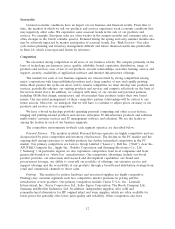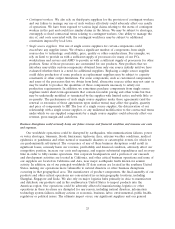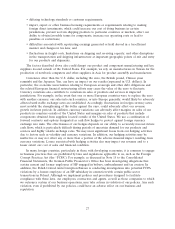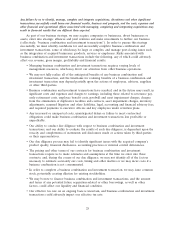HP 2014 Annual Report Download - page 28
Download and view the complete annual report
Please find page 28 of the 2014 HP annual report below. You can navigate through the pages in the report by either clicking on the pages listed below, or by using the keyword search tool below to find specific information within the annual report.on this strategy, we need to continue evolving our focus towards the delivery of integrated IT solutions
for our customers and to continue to invest and expand into cloud computing, security, big data and
mobility. Any failure to successfully execute this strategy, including any failure to invest sufficiently in
strategic growth areas, could adversely affect our business, results of operation and financial results.
The process of developing new high-technology products, software, services and solutions and
enhancing existing hardware and software products, services and solutions is complex, costly and
uncertain, and any failure by us to anticipate customers’ changing needs and emerging technological
trends accurately could significantly harm our market share and results of operations. For example, as
the transition to an environment characterized by cloud-based computing and software being delivered
as a service progresses, we must continue to successfully develop and deploy cloud-based solutions for
our customers. We must make long-term investments, develop or obtain, and protect, appropriate
intellectual property, and commit significant research and development and other resources before
knowing whether our predictions will accurately reflect customer demand for our products, services and
solutions. In addition, after we develop a product, we must be able to manufacture appropriate volumes
quickly while also managing costs and preserving margins. To accomplish this, we must accurately
forecast volumes, mixes of products and configurations that meet customer requirements, and we may
not succeed at doing so within a given product’s life cycle or at all. Any delay in the development,
production or marketing of a new product, service or solution could result in us not being among the
first to market, which could further harm our competitive position.
In the course of conducting our business, we must adequately address quality issues associated with
our products, services and solutions, including defects in our engineering, design and manufacturing
processes and unsatisfactory performance under service contracts, as well as defects in third-party
components included in our products and unsatisfactory performance or even malicious acts by third-
party contractors or subcontractors or the employees of those contractors or subcontractors. In order to
address quality issues, we work extensively with our customers and suppliers and engage in product
testing to determine the causes of problems and to develop and implement appropriate solutions.
However, the products, services and solutions that we offer are complex, and our regular testing and
quality control efforts may not be effective in controlling or detecting all quality issues or errata,
particularly with respect to faulty components manufactured by third-parties. If we are unable to
determine the cause, find an appropriate solution or offer a temporary fix (or ‘‘patch’’) to address
quality issues with our products, we may delay shipment to customers, which would delay revenue
recognition and could adversely affect our revenue and reported results. Addressing quality issues can
be expensive and may result in additional warranty, replacement and other costs, adversely affecting
our profits. If new or existing customers have difficulty operating our products or are dissatisfied with
our services or solutions, our results of operations could be adversely affected, and we could face
possible claims if we fail to meet our customers’ expectations. In addition, quality issues can impair our
relationships with new or existing customers and adversely affect our brand and reputation, which
could, in turn, adversely affect our results of operations.
Our plan to separate into two independent publicly-traded companies is subject to various risks and
uncertainties and may not be completed in accordance with the expected plans or anticipated timeline, or at
all, and will involve significant time and expense, which could disrupt or adversely affect our business.
On October 6, 2014, we announced plans to separate into two independent publicly-traded
companies. The separation, which is currently targeted to be completed by the end of fiscal 2015, is
subject to approval by our Board of Directors of the final terms of the separation and market,
regulatory and certain other conditions. Unanticipated developments, including changes in the
competitive conditions of Hewlett-Packard Enterprise’s and HP Inc.’s respective markets, possible
delays in obtaining various tax opinions or rulings, regulatory approvals or clearances, the uncertainty
of the financial markets and challenges in executing the separation, could delay or prevent the
20
























